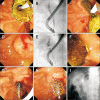Endoscopic Reintervention for Recurrence of Malignant Biliary Obstruction: Developing the Best Strategy
- PMID: 35193992
- PMCID: PMC9289839
- DOI: 10.5009/gnl210228
Endoscopic Reintervention for Recurrence of Malignant Biliary Obstruction: Developing the Best Strategy
Abstract
Drainage therapy for malignant biliary obstruction (MBO) includes trans-papillary endoscopic retrograde biliary drainage (ERBD), percutaneous transhepatic biliary drainage (PTBD), and trans-gastrointestinal endoscopic ultrasound-guided biliary drainage (EUS-BD). With the development of chemotherapy, many MBO cases end up needing endoscopic reintervention (E-RI) for recurrent biliary obstruction. To achieve a successful E-RI, it is necessary to understand the various findings regarding E-RI in MBO cases reported to date. Therefore, in this review, we focus on E-RI for ERBD of distal MBO, ERBD of hilar MBO, and EUS-BD. To plan an appropriate E-RI strategy for biliary stent occlusion for MBO, the following must be considered on a case-by-case basis: the urgency of the drainage, the cause of the occlusion, the original route of drainage (PTBD/ERBD/EUS-BD), the initial stent used (plastic stent or self-expandable metallic stent), and in the case of self-expandable metallic stents, the type used (fully covered or uncovered). Regardless of the original method of stent placement, if the inflammation caused by obstructive cholangitis is severe and/or the patient is in shock, PTBD should be considered as the first choice. Finally, it is important to keep in mind that in many cases, performing E-RI will be difficult.
Keywords: Interventional ultrasonography; Jaundice; Stent; obstructive.
Conflict of interest statement
No potential conflict of interest relevant to this article was reported.
Figures



Similar articles
-
EUS-guided biliary drainage with electrocautery-enhanced lumen-apposing metal stent placement should replace PTBD after ERCP failure in patients with distal tumoral biliary obstruction: a large real-life study.Surg Endosc. 2022 May;36(5):3365-3373. doi: 10.1007/s00464-021-08653-1. Epub 2021 Oct 4. Surg Endosc. 2022. PMID: 34606007
-
Use of endoscopic ultrasound-guided biliary drainage as a rescue of re-intervention after the placement of multiple metallic stents for malignant hilar biliary obstruction.J Hepatobiliary Pancreat Sci. 2022 Mar;29(3):404-414. doi: 10.1002/jhbp.1059. Epub 2021 Nov 18. J Hepatobiliary Pancreat Sci. 2022. PMID: 34661973
-
Multicenter study on endoscopic ultrasound-guided expandable biliary metal stent placement: choice of access route, direction of stent insertion, and drainage route.Dig Endosc. 2014 May;26(3):430-5. doi: 10.1111/den.12153. Epub 2013 Aug 13. Dig Endosc. 2014. PMID: 23941261
-
Combination of endoscopic retrograde cholangiopancreatography and endoscopic ultrasonography-guided biliary drainage in malignant hilar biliary obstruction.Dig Endosc. 2019 Apr;31 Suppl 1:50-54. doi: 10.1111/den.13371. Dig Endosc. 2019. PMID: 30994233 Review.
-
Lumen-apposing metal stents for malignant biliary obstruction: Is this the ultimate horizon of our experience?World J Gastroenterol. 2019 Aug 7;25(29):3857-3869. doi: 10.3748/wjg.v25.i29.3857. World J Gastroenterol. 2019. PMID: 31413524 Free PMC article. Review.
Cited by
-
Role of radiofrequency ablation in advanced malignant hilar biliary obstruction.Clin Endosc. 2023 Mar;56(2):155-163. doi: 10.5946/ce.2022.218. Epub 2023 Jan 16. Clin Endosc. 2023. PMID: 36646424 Free PMC article. Review.
-
How should a therapeutic strategy be constructed for acute cholecystitis after self-expanding metal stent placement for malignant biliary obstruction?Clin Endosc. 2022 Nov;55(6):757-759. doi: 10.5946/ce.2022.275. Epub 2022 Nov 1. Clin Endosc. 2022. PMID: 36464824 Free PMC article. No abstract available.
-
Endoscopic ultrasound-guided intervention for inaccessible papilla in advanced malignant hilar biliary obstruction.Clin Endosc. 2023 Mar;56(2):143-154. doi: 10.5946/ce.2022.198. Epub 2023 Feb 17. Clin Endosc. 2023. PMID: 36796854 Free PMC article. Review.
-
The role of endoscopy in malignant hilar obstruction.Ann Gastroenterol. 2023 Jul-Aug;36(4):347-359. doi: 10.20524/aog.2023.0810. Epub 2023 May 29. Ann Gastroenterol. 2023. PMID: 37395999 Free PMC article. Review.
-
Efficacy Analysis of Suprapapillary versus Transpapillary Self-Expandable Metal Stents According to the Level of Obstruction in Malignant Extrahepatic Biliary Obstruction.Gut Liver. 2023 Sep 15;17(5):806-813. doi: 10.5009/gnl220437. Epub 2023 Apr 4. Gut Liver. 2023. PMID: 37013456 Free PMC article.
References
-
- Takenaka M, Fujita T, Sugiyama D, et al. What is the most adapted indication of prophylactic pancreatic duct stent within the high-risk group of post-endoscopic retrograde cholangiopancreatography pancreatitis? Using the propensity score analysis. J Hepatobiliary Pancreat Sci. 2014;21:275–280. doi: 10.1002/jhbp.24. - DOI - PubMed
-
- Logiudice FP, Bernardo WM, Galetti F, et al. Endoscopic ultrasound-guided vs endoscopic retrograde cholangiopancreatography biliary drainage for obstructed distal malignant biliary strictures: a systematic review and meta-analysis. World J Gastrointest Endosc. 2019;11:281–291. doi: 10.4253/wjge.v11.i4.281. - DOI - PMC - PubMed
Publication types
MeSH terms
LinkOut - more resources
Full Text Sources

